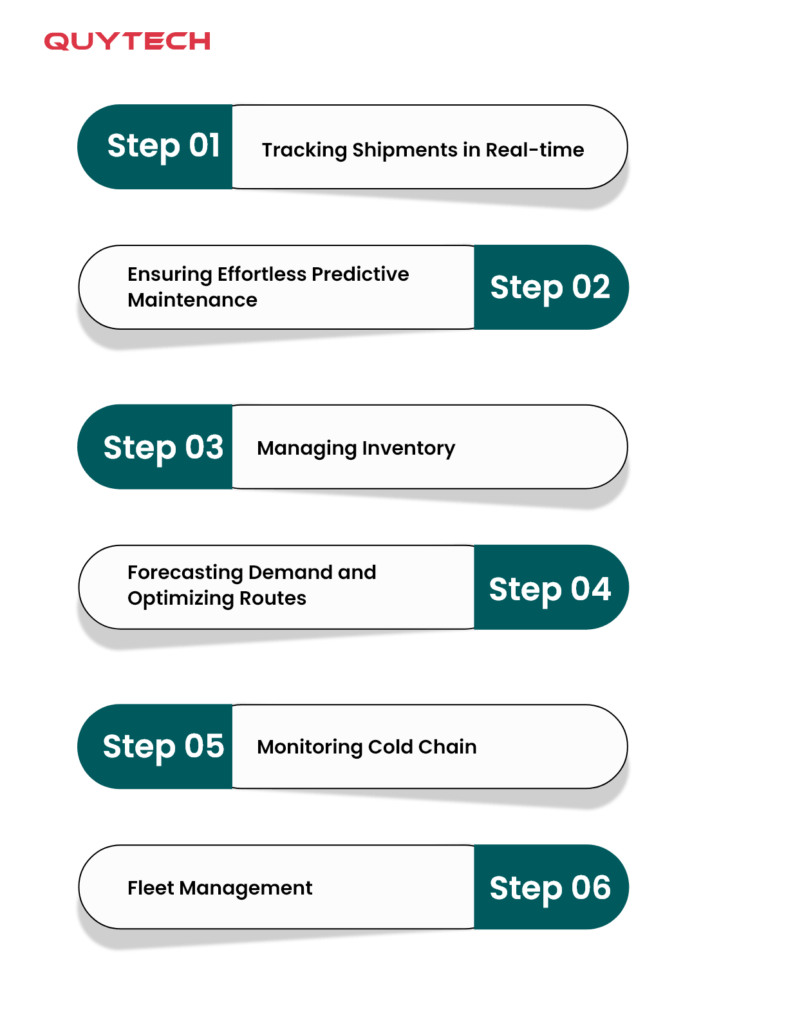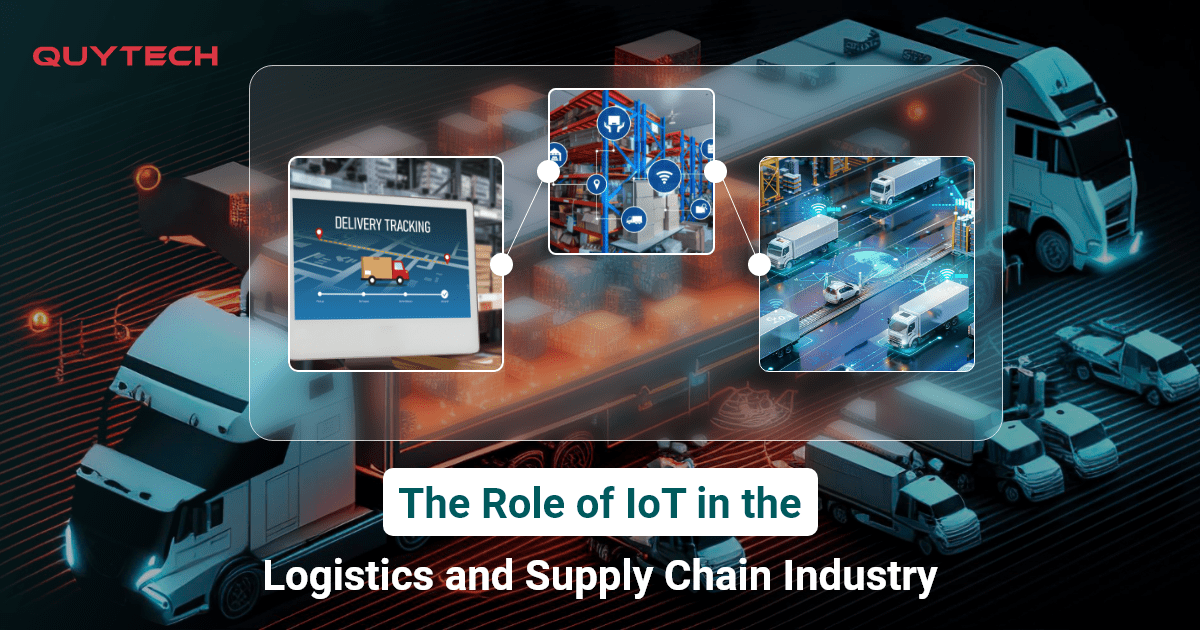Nearly two decades ago, the logistics and supply chain industry was a complex web of manual processes with bare minimum shipment visibility. Shipments had to be shrouded in uncertainty and businesses used to frequently deal with problems like loss of shipment, delayed deliveries, and increased cost.
The arrival and growing adoption of technology, especially, the IoT in logistics and supply chain management has changed the entire scenario. The Internet of Things in the logistics and supply chain industry brings in benefits like real-time shipment tracking and monitoring to allow businesses to respond promptly to unforeseen challenges to ensure safe and timely movement of goods from the source to the destination while enhancing customer satisfaction.
Isn’t amazing how IoT transforms the way the logistics and supply chain world works? Read on to explore everything, including what is IoT in logistics, the role of IoT in logistics and supply chain management, types of Internet of Things in logistics, benefits of IoT in logistics, IoT in logistics examples, and a lot more.
IoT in the Logistics and Supply Chain Industry- Market Statistics
In simple terms, IoT in logistics and supply chain management is about integrating physical devices that can connect within one network to communicate and share data. Devices, such as sensors, equipment, fleet, and others, can be interconnected within one internet network to exchange data and build a transparent ecosystem. Sensors collect crucial data like temperature, speed, or geographical location, exchange it with other devices using a Wi-Fi or mobile network, and the IoT-enabled solutions or apps analyze the same to fetch crucial insights. These insights can then be used for route optimization and predictive maintenance.
Now, let’s check out some interesting statistics associated with the Internet of Things and supply chain management:
- The market size for IoT-powered logistics and supply chain management is forecasted to reach US $116.70 billion in 2030.
- The market is expected to grow at a compound annual growth rate (CAGR) of a whopping 12.3% from 2023 to 2030.
- Key drivers behind the increasing demand for IoT and supply chain management include the rising need for real-time shipment visibility, transparency among stakeholders, and control over shipments.
Benefits of IoT in the Logistics and Supply Chain Sector
IoT in logistics and supply chain renders the following amazing benefits or advantages:
#1 Improved Visibility and Shipment Tracking
IoT in supply chain and logistics helps with real-time shipment monitoring right when the consignment ships from the source until it reaches the destination. It enables supply chain managers to detect anomalies or predict delays to timely intervene and take corrective actions.
The data collected by IoT-enabled sensors is further processed to gain actionable insights for improving decision making associated with resource allocation, shipment schedules, and optimizing routes.
#2 Enhanced Operational Efficiency and Productivity
IoT-enabled applications and solutions automate time-intensive tasks with high accuracy and efficiency. They can help optimize workflows to reduce lead times. Automation minimizes dependency on human resources while significantly boosting productivity.
#3 Reduced Cost
Merging the Internet of Things and supply chain management minimizes the overall operational costs. By providing real-time visibility on shipments, IoT helps to reduce issues like late deliveries, loss of shipments, and inventory overflow and stock-outs, which further controls the cost of moving goods from one place to another. Well-optimized routes also reduce the route optimization cost.
#4 Enhanced Customer Satisfaction
Integrating IoT in logistics and supply chain applications contributes to improving delivery accuracy, which leads to enhanced customer satisfaction and loyalty. Real-time shipment tracking and timely updates and notifications keep customers informed about the status of their shipments.
#5 Optimized Supply Chain
IoT-powered analytics enable supply chain managers to predict future trends, optimize supply chain planning, and ensure accurate demand forecasting. They can also mitigate potential risks with real-time monitoring. It not only saves costs but also ensures better supply chain management.
The Role of IoT in the Logistics and Supply Chain Sector: Exploring Top Use Cases or Applications
Integration of IoT does wonders in the logistics and supply chain sector. Here are some IoT logistics applications or IoT applications in supply chain to support this statement:

Use Case #1: Tracking Shipments in Real-time
It is probably one of the best uses of IoT in logistics. The technology reads data from RFID tags and sensors attached to the shipments. Based on this data, supply chain managers can track the location of pallets, containers, and vehicles in real-time. Tracking shipments throughout their movement from source to destination enables avoiding potential delays, helps with quick re-routing, and improves delivery times.
Use Case #2 Ensuring Effortless Predictive Maintenance
IoT sensors can monitor the health of various equipment such as forklifts, trucks, and warehouse machinery. IoT solutions in logistics can identify potential issues early so that managers can schedule maintenance proactively to minimize downtime and costs.
Use Case #3 Managing Inventory
Overflowing and stockout of inventory can be a big problem for any business, including logistics and supply chain. The Internet of Things technology when used in warehouses and distribution centers can help with real-time inventory tracking. It uses RFID tags and barcode scanners to automate inventory counts for better accuracy and efficiency.
Use Case #4 Forecasting Demand and Optimizing Routes
IoT-powered devices when connected with applications and solutions can help supply chain managers to accurately forecast demand and optimize inventory levels. The technology can also help with route optimization, which can further minimize fuel consumption and reduce delivery time and costs.
Use Case #5 Monitoring Cold Chain
When it comes to cold chain monitoring, IoT sensors and IoT solutions in logistics can be a big help. These sensors can monitor temperature and humidity levels in vehicles like refrigerated trucks, containers, and warehouses. It keeps the perishable items pristine and of optimum quality and safety. These sensors send real-time alerts if temperature or humidity levels exceed or decrease, allowing logistics managers to take immediate action.
Use Case #6 Fleet Management
IoT-enabled fleet management can assist logistics managers with knowing the vehicles’ location in real-time. It can also help with truck weight management and ensuring each vehicle adheres to the defined speeds. It ensures vehicle idling time and reduces transportation costs.
How Does the Internet of Things in the Logistics and Supply Chain Industry Work?
Here is a step-by-step process to understand how IoT works in the logistics and supply chain sector:
#1 Integrating and Connecting Devices
It includes IoT devices installation; devices like sensors, RFID tags, GPS trackers, and more are attached to pallets, containers, shipments, vehicles, and warehouse equipment. Once attached, these devices are further connected to different IoT-enabled systems via Wi-Fi, Bluetooth, satellite communication, or mobile networks.
#2 Collecting and Transmitting Data
IoT devices collect data based on location, temperature, humidity, shock, and other factors. This data is then transmitted to a cloud-based platform or data center or directly to an IoT-powered application or solution that manages the supply chain.
#3 Processing and Analyzing Data
In the next step, the collected data is processed to extract meaningful information. For the analysis, advanced analytics and AI algorithms are used. This data can be used in warehouse and inventory management, route optimization, and other critical operations.
#4 Taking the Right Action
The extracted insights are used to optimize the operations mentioned in the previous point. It can also help in knowing the exact status of the supply chain, including the shipment’s location. If the IoT-powered solution or app predicts any problem (delivery delay due to congestion or any other reason, temperature-related problem, etc.) the managers can take corrective action.
Top Companies Using IoT in Supply Chain Management
To understand the role of IoT in logistics and supply chain better, let’s look at some examples of IoT in logistics.
#1 Walmart
When it comes to real-world IoT in logistics examples, Walmart is a perfect name to mention. The company uses RFID technology for real-time inventory tracking and management. IoT sensors also help to monitor the temperature of perishable products during supply chain management.
#2 Amazon
Amazon also uses the Internet of Things technology to automate its warehouse operations, which further improves efficiency and minimizes labor costs. IoT also facilitates real-time tracking of consignments to ensure accurate delivery estimates and enhance customer satisfaction.
#3 DHL
DHL utilizes the Internet of Things sensors to take care of conditions like temperature, humidity, and shock of the shipment. The company also helps with predictive maintenance of equipment to avoid failures and predict maintenance.
IoT and Supply Chain: Building Custom IoT Solutions for Logistics
Now that we have mentioned the use of IoT in supply chain management or logistics, it’s time to read about developing custom IoT-powered solutions that can transform this industry. If you have a technical background and thorough knowledge of app/solution development, do the following to build your dream IoT application for logistics and supply chain management on your own, do the following:
- Create a detailed list of your IoT app/solutions requirements, including its tech stack, features, USPs, functionality, monetization strategies, and objectives.
- Build UI/UX design
- Create an MVP and get it validated by your target audience and investors.
- Build a full-fledged app or solution.
- Test each component and launch the application.
- Monitor the app for continuous refinement, feature updates, and bug fixes.
Alternatively, you can connect with the best IoT app development company and share your exact requirements to turn your IoT solution or app development dream into reality. A reputed firm will commit to timely delivery, high-quality, and regular reporting during the entire development.
Internet of Things in Supply Chain Management in 2025 and Beyond
Considering the amazing benefits and use cases of IoT in the logistics and supply chain industry, it would be right to say that the technology has a promising future. IoT will be used increasingly for hyper-connected supply chains for better real-time visibility and predictive analytics.
IoT logistics companies will build more IoT and AI-powered logistics applications for intelligence decision-making associated with route optimization, inventory tracking, and inventory management. These technologies will also eliminate dependency on human resources to improve efficiency, forecast demand, and minimize costs.
In 2025, we may also see a spike in smart warehouses where the Internet of Things-powered devices will help in optimum space utilization and order fulfillment. The technology will further build a collaborative supply chain ecosystem.
Conclusion
The conventional way of logistics and supply chain management provided no visibility on the status of the shipment and often led to shipment delays, losses, and other problems. The use of IoT in logistics has revolutionized the way shipments are managed, tracked, and monitored. There is no denying that IoT has brought a totally new era of efficiency and transparency in the entire supply chain management.
This blog is for those who want to know the role of IoT in the logistics and supply chain industry. Along with unique use cases of the Internet of Things in logistics and supply chain management, it highlights the benefits, types, future, and a lot more about this technology. We have also mentioned how to implement IoT in logistics by building a customized and scalable IoT application.



